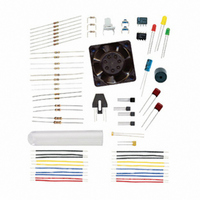130-28176 Parallax Inc, 130-28176 Datasheet - Page 256

130-28176
Manufacturer Part Number
130-28176
Description
KIT PARTS PROCESS CONTROL
Manufacturer
Parallax Inc
Specifications of 130-28176
Accessory Type
Education Kit
Product
Microcontroller Accessories
Lead Free Status / RoHS Status
Contains lead / RoHS non-compliant
For Use With/related Products
Board of Education Full Kit
Lead Free Status / RoHS Status
Lead free / RoHS Compliant, Contains lead / RoHS non-compliant
- Current page: 256 of 330
- Download datasheet (11Mb)
Page 246 · Process Control
tube, sunlight falling on the tube, or the resistor aging. The amount of heat added and
removed is seldom constant over long periods of time.
In an oil-flow system, the drive element, the pump, is controlled to maintain a desired oil
flow rate. A sudden change in the system may be a valve closing, blocking one path for
oil flow. A slow change in the system may be a filter gradually clogging or the oil
temperature changing affecting the viscosity or 'thickness'. The pump needs to adjust in
order to compensate for these changes.
One other system to consider is an automobile. Typically we want the car to maintain a
constant speed on the highway. The engine makes up for friction losses from the tires on
the pavement and the air blowing over the car. When the car is maintaining a constant
speed, the system is in equilibrium and our foot keeps the accelerator in a constant
position. When conditions change, such as the car climbing a hill, the car's velocity
changes. The forces increase on the car, removing more energy than the engine is
supplying, and the car begins to slow. Without depressing the accelerator more, will the
car eventually come to a stop on the hill? No, it will slow to a lower constant speed
where once again energy losses equal energy input, and a new equilibrium is reached.
Throttle position directly relates to the power demanded from the engine. This power
moves the mass of the car and overcomes friction, wind resistance, gravity due to road
incline, etc. If all of these conditions (disturbances) were constant, our car would
stabilize as some constant speed. When you want to go 55 mph on level highway, this
would correlate to a specific throttle position. If all conditions stay the same, lock in this
throttle position and your speed will not change.
Now, think carefully about how you might react in an effort to keep the car going at a
constant speed. Consider how you would respond in pressing the gas pedal relative to
continually watching the speedometer. The speedometer is the measuring device (sensor)
and it is providing you feedback as to how your process is going. We will relate your
“natural” reaction to the individual principles of a PID controller as you attempt to drive
a steady 55 miles per hour (mph).
First, let’s consider your simple response to noticing that you are going 5 mph slower
than you desire. You respond by pressing the gas pedal a certain amount. If you had
been going 10 mph slower than desired, your reaction would naturally be more forceful.
And, likewise if you had been only slightly below the target speed your tendency would
Related parts for 130-28176
Image
Part Number
Description
Manufacturer
Datasheet
Request
R

Part Number:
Description:
KIT PROPELLER EDU PROJECT PARTS
Manufacturer:
Parallax Inc
Datasheet:

Part Number:
Description:
KIT PARTS SMART SENSORS
Manufacturer:
Parallax Inc
Datasheet:

Part Number:
Description:
Microcontroller Modules & Accessories DISCONTINUED BY PARALLAX
Manufacturer:
Parallax Inc

Part Number:
Description:
BOOK UNDERSTANDING SIGNALS
Manufacturer:
Parallax Inc
Datasheet:

Part Number:
Description:
COMPETITION RING FOR SUMOBOT
Manufacturer:
Parallax Inc
Datasheet:

Part Number:
Description:
TEXT INFRARED REMOTE FOR BOE-BOT
Manufacturer:
Parallax Inc
Datasheet:

Part Number:
Description:
Microcontroller Modules & Accessories DISCONTINUED BY PARALLAX
Manufacturer:
Parallax Inc

Part Number:
Description:
BOOK UNDERSTANDING SIGNALS
Manufacturer:
Parallax Inc
Datasheet:

Part Number:
Description:
BOARD EXPERIMENT+LCD NX-1000
Manufacturer:
Parallax Inc
Datasheet:

Part Number:
Description:
IC MCU 2K FLASH 50MHZ SO-18
Manufacturer:
Parallax Inc
Datasheet:













